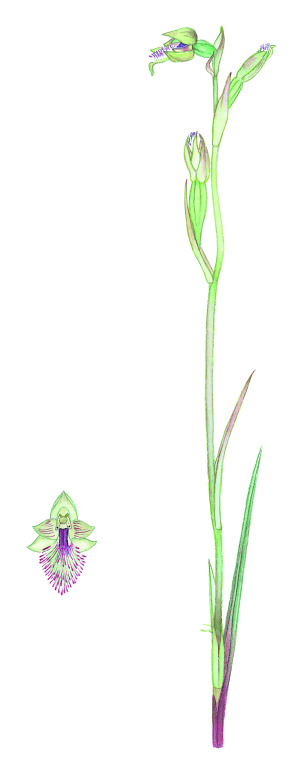Calochilus herbaceus
Lindl.Flowering plant 15–40 cm tall, slender to stout. Leaf erect, very short, linear-lanceolate, to 6 cm long, much shorter than raceme, rigid, fleshy, triangular in cross-section, channelled. Stem bracts 2, copper-coloured. Flowers 1–8, pale green to brownish with reddish stipes and purplish labellum hairs; subtending bract lanceolate, tapering to fine point, shorter than flower; pedicel (excluding ovary) 5–13 mm long; dorsal sepal erect, ovate, 9–12 mm long, concave, acute; lateral sepals ovate, 8–10 mm long, spreading below labellum; petals spreading, ovate-lanceolate, much shorter and narrower than dorsal sepal, yellow with darker stripes. Labellum curved, with fleshy rectangular base and wide triangular lamina, 9–14 mm long; margins fringed with reddish-purple hairs with metallic lustre; basal portion covered by 2–6 smooth, longitudinal, metallic-blue plates; central portion moderately covered with bristly purple hairs; tip recurved, ending in short glandular strap-like tail. Column short, winged, with 2 purple, eye-like glands at base, connected by an obscure ridge. Flowers Oct.–Jan.
GleP, VVP, GipP, OtP, WaP, CVU, GGr, EGL, HSF, OtR, Strz. Also Tas. Widespread but localised on poorly drained sandy soils and peat in coastal scrubs, sedgeland or heathland, often in disturbed sites.
The similar Calochilus campestris generally has more flowers that are larger and a much longer leaf.
 Spinning
Spinning


